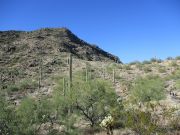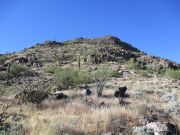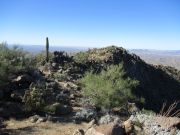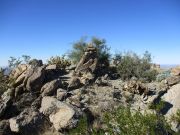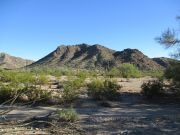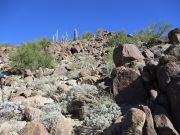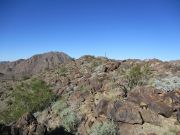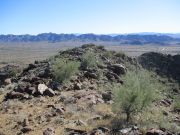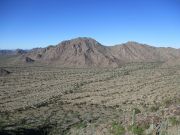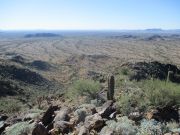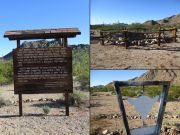
The Mountains of Arizona
www.surgent.net |
|
Peak 2799 • Peak 2065 Matthias proposed these two peaks as something to climb the day after Thanksgiving. They lie in the Maricopa Mountains, the part north and east of State Routes AZ-238 and AZ-85. The peaks here tend to be stand-alone, rather than all collected into a long ridge. There are easily two dozen ranked summits herein, and I have a grand total of four completed. Thus, I was open to any peaks he proposed. In fact, I did no homework to prepare. I did not know which peaks he had planned until we got close to them. The two peaks lie on either side (north and south) of the Butterfield Overland Mail Route. This route began in St. Louis, angled south through Texas and the New Mexico Territory (before Arizona was a territory itself), then crossed the Colorado River at current-day Yuma, then up the California coast ending in San Francisco. It was a mail route, similar to the Pony Express, but it used horse teams and coaches rather than relying on a single rider along its segments. Passengers could book travel on these coaches too. It was superceded by the telegraph and later, railroads. The pass through these mountains was convenient for this mail route, as it is flat and straight. This pass was also used by the Mormon Battalion on its long march to the West Coast in 1846-47, part of the Mexican-American War. There is a tank called Fortymile Desert Tank shown on the maps. It was a hand-built rocky cistern filled with water for the horse teams. An interpretive sign nearby explains it all. Also, there is a marker for the Mormon Battalion too. I was aware of the Butterfield history, but not of the Mormon Battalion history. And decades earlier, in the 1770s, it was a segment used by Juan Bautista de Anza when this area was under Spanish control. It was a natural route to follow which allowed easier access to current-day California. Parts of the current-day road are marked with little "de Anza" stickers on plastic posts, and the paved route AZ-238/Gila Bend Road is also designated as the Anza Historic Trail. Needless to say, this pass has a lot of fascinating history attached to it. As part of the non-historic Stender-Surgent 2022 expedition, it would serve these two intrepid explorers well as a convenient entryway into the heart of the range. These days, the road is rough and sandy, prone to washouts and with sections that lean. It is not a rocky road. Were it not for the sand, the washouts and the leans, it would be a decent road. It does require good clearance, 4-wheel drive nice to have. I met Matthias at his place at 7:30 a.m., and he drove us via Maricopa onto AZ-238 and to one of the entry points into the range, much of it now part of the Sonoran Desert National Monument. It's only been in the past year these roads have been re-opened for vehicle travel. For about fifteen years, after the range was designated a National Monument, these roads were gated closed, which prohibited access into the range and essentially cut off any climbing that was farther than a couple miles from the highway. From the highway, Matthias turned onto the western entry point that leads to "Gap Well" shown on the map. About two miles later, we went eastbound on the main "Butterfield Stage Route" road. Up ahead was a big hulk of a peak, with very steep rocky slopes. I had no idea which peaks we'd be climbing, but this big peak was our primary peak. From this side, it looked real steep, but we'd be approaching it from the opposite side. About five miles later, we were in the heart of the range, the pass narrowing a little. We parked a little east of Peak 2799 and would start our hike from here.
Date: November 25, 2022
• Elevation: 2,799 feet
• Prominence: 879 feet
• Distance: 3.8 miles
• Time: 4 hours
• Gain: 1,150 feet
• Conditions: Clear and blue, not a cloud to be seen
• Teammate: Matthias Stender
• Prog-rock bands played: Deus ex Machina, Picchio Dal Pozzio, The Aristocrats
Arizona
•
Main
•
PB
•
LoJ
We started walking at 9:00 sharp, following a sandy drainage north from the road. It braided but the ground was open enough so that we could find our way, drainage or not. The drainage bends west, aiming for a low pass about a half-mile ahead. Peak 2799's summit ridge was visible after a short while. The summit itself lies west of the part we could see and would not be visible to us until we were within yards of it.
The drainages helped in that they were often wide and brush free. The sand was packed solid so that we could walk quickly on it, not sink in three inches with every step. We were soon close to the low pass and at the foot of the slopes we wanted to take upward to the top. The route we had in mind was an initial slope up to a flat knob about halfway up, then a steep grind to the summit ridge. All this was visible from a distance. We had gained about 200 feet since we started the hike, in about a mile.
The lower half went well. The slope lay back well and was rocky, but open enough so that the rocks formed steps or short ledges. There were no awkward small cliffs to scramble up, just good old-fashioned rocky slope. We gained about 400 more feet and topped out on a small ridge. This was a little below the higher saddle directly below the last steep slope. We walked over to this last saddle, and got ready for the big hike of the day, another 550-600 feet of uphill slogging.
The slopes always look more steep from a distance, but once below it and on it, the slopes lay back nicely, at least at first. The first 300 feet above the high saddle was just moderately steep hillside, with scattered rock outcrops and brush. The rocks formed more steps and were almost always solid and dependable to step on.
The last 300 feet was much steeper. We were now within more rocks, but these helped. They were solid and stable and we never once needed hands to clamber up anything. We moved carefully through these upper rocks, and surprisingly, this segment went extremely well. We were now below the topmost rock crown, what we had seen from below. Once atop it, the highpoint was another couple hundred feet of level walking away.
We covered this final segment quickly and stood atop Peak 2799. A large cairn marks the top, but a handful of rocky fins could be the highpoint too. We tagged them all and sat down for a summit break. It had taken us just under 2 hours to get here, a 1,150-foot gain in 1.9 miles. The day was sunny, slightly breezy, and clear. Temperatures were pleasant, and we could see mountains all around us, even as far south as the peaks on the Barry Goldwater Range. Woolsey Peak near Gila Bend rose west, a darker-colored mound compared to the other peaks out that way. We spent about 20 minutes up top.
We looked for a register when we first arrived but couldn't find one, assuming it to be stashed within or near the big rock outcrop. Instead, we found it about a dozen feet away, in a crook of a rock near the west tip of the summit. A small unnatural-looking mound of rocks suggested a cairn, and sure enough, there was the register. Names went back about 20 years, up to about 2008. Then nothing until 2017, then nothing until us. The road closures mentioned earlier played a huge role in throttling access to this peak for over a dozen years. We suspect others that we know have been here may not have found the register. It wasn't obvious for us, either.
We exited out the same way, carefully stepping down the steep slopes and rocks until we were on the lesser slopes, and then again down that first slope until we were back onto the flats with the sandy drainages. We arrived back at Matthias' car close to 1 p.m., a 4-hour round-trip hike. We piled into his car to get moving and the ignition wouldn't turn over... this was interesting... so Matthias jumped it with one of those portable battery starter packs, which worked. That was a crisis averted.
Matthias drove us out about a mile, until were were at the Fortymile Tank, where there is meager parking. So we park and get our stuff in order for our next hike, and wouldn't you know, we hear engines coming up. It was a foursome on quads, two men and two women, looking in their 60s I guessed. One guy had a cooler strapped to his handlebars and was drinking a beer, not to mention riding off-road in Wilderness, which isn't allowed if the rules apply to everyone. And they had pistols holstered. Not one of them said "hi" or "boo" to us. They just got off, talked amongst themselves and made a racket. We wondered what they planned to shoot. We had better things planned, a hike up Peak 2065, south of us.
Elevation: 2,065 feet
• Prominence: 505 feet
• Distance: 2.6 miles
• Time: 2 hours
• Gain: 623 feet
• Conditions: Clear and blue, slight breeze, warm in the sun
PB
•
LoJ
Peak 2065 lies a little less than a mile south of the road. Getting up it took some discussion. Matthias was willing to charge up one of the slopes facing us. Me, I wasn't so eager. I suggested we hike to the right (west) of the peak and see what was behind. Matthias was agreeable, and we did, and we saw a long rock-strewn slope and gully that led to the high ridge, and while it looked like a mess, it also looked like it would go. To me, at least, it seemed like a better option, i.e. a higher probability of success, i.e. a higher probability of success for me.
So we entered into this rocky canyon, trudging upward and soon onto the rocks. A gully cuts up the slope to our right. To its left and roughly centered within the canyon is a ridge. As we climbed higher, we naturally gravitated more onto the ridge. The rocks here were big and heaped haphazardly, but there was always a way up them, at worst the scrambling requiring hands maybe once or twice. It was a lot rockier than Peak 2799, but nothing was a show-stopper. We finally were about as high as the rocks would take us. The last forty feet was up a steep scree slope with loose footing. Once up that, we were now on the summit ridge, which was as rocky as what we'd just come up.
The highpoint was at the far end of the ridge relative to where we came up (it almost seems always that way). But the traverse to it was very simple and in moments, we were on top of Peak 2065. We signed into the register which held just a few names. Given that this peak isn't one of the larger peaks in the range, it's not surprising that it sees relatively fewer people.
The views up here were good, the same bright blue clear skies as a couple hours earlier on Peak 2799, which dominated the north skyline. East was Estrella Benchmark, south were the peaks in the Maricopas, west the peaks by Gila Bend. Naturally, the views from atop both peaks were mostly the same. We spent our usual 20 minutes up top, resting and having a snack and drink.
When it was time to leave, Matthias wanted to descend a steep ridge that fell directly off the summit. Me, I wasn't up for surprises so I opted to descend the same western gully as we ascended. Given that Matthias was cool to consider my route for the ascent, I had no issue with him going that way and me my way.
The descent went fine. That top 40 feet of scree wasn't fun. I essentially scooted down it on my butt until I was on the firmer rock. From here, it was just a matter of eyeballing routes down the rock. I cliffed myself out once, and had to reclimb about fifteen feet to catch a parallel slope. The descent went slow but it was enjoyable. I like these maze-of-rocks descents, where I can use my hands to help shimmy down cracks, not beholden to always fining the easiest chute down. Maybe a couple times I was on Class-3 rock, but I had no issues at all. I was soon down off the rocks and back to the desert flats, and in about ten minutes was back at Matthias' vehicle. He had beaten me by 15 minutes, he said.
It was 3:30 now. The two peaks combined covered 6.4 miles with about 1,900 feet of gain. It was a rocky day, but enjoyable too. The rocks were our friend today. The now six peaks I have climbed in this range have all been this way, perhaps the friendliest rocky slopes in the state. The rocks on Peak 2065 were a little more weathered with that kibble-sized gravel, compared to Peak 2799.
We exited back onto pavement and back to his place in Ahwatukee. The music for today were two Italian bands, and the Aristocrats. The Italian bands, in my opinion, sounded jazzier, in a couple cases kind of reminded me of early King Crimson, when Ian McDonald was tooting the sax for them. Matthias emailed me later to explain the Aristocrats are a German-English-American trio.
|
|

